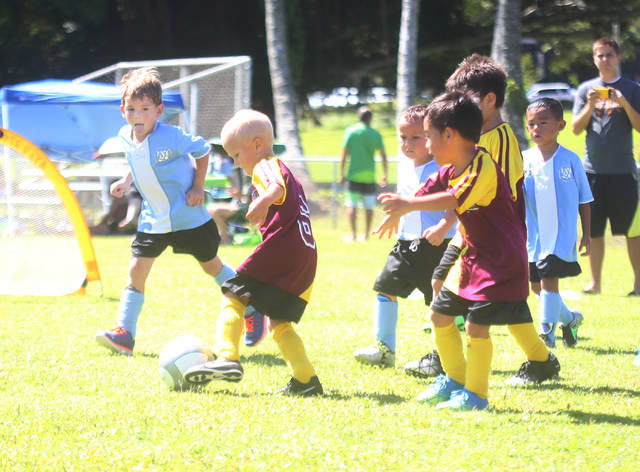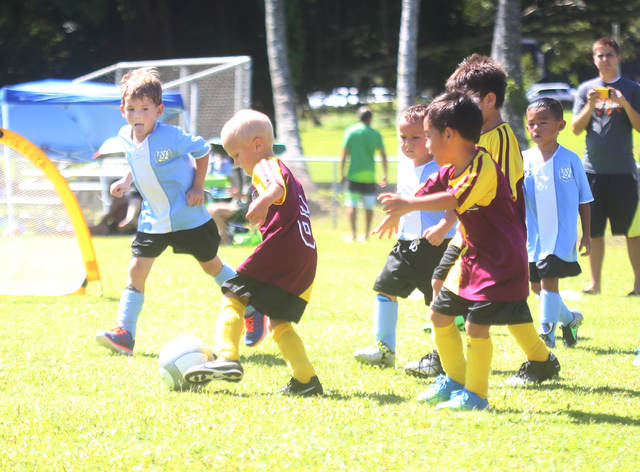It was 25 years ago at a national American Youth Soccer Organization meeting in Phoenix when Maurice Miranda first heard mention of the approaching threat.
For Miranda, it came like a bolt out of the blue, something he had never considered.
“I remember thinking, ‘Wow, where did that come from?’” Miranda said the other day in a phone conversation. “In essence, that’s where we are today and there’s not much doubt about that.”
The warning for the collection of local and regional youth soccer directors in attendance was loud and clear. A speaker said, “Welcome to the last bastion against the professionalism of our youth,” and it was an observation that stuck like glue to Miranda.
In the quarter century since Miranda heard those words and considered their meaning, it appears the battle for our children is being won by the monied interests who see our keiki as their personal profit center.
Any parent over 30 may well be unaware of the targeting of youth by what is being called the youth sports tourism industry, a kind of outgrowth of the travel team concept that some marketers decided could lift the curtains on a vast profit center.
Unfortunately, the marketers were right. Here’s an excerpt from Poynter’s James Warren, who, in August, wrote for Vanity Fair about developments in this regard in Westfield, Ind.:
“Westfield recently built a sports mini-metropolis on 400 acres, with 31 full-size outdoor soccer fields, 26 baseball diamonds and three full-sized soccer fields indoors. It estimates $145 million was spent in and near the area last year by parents and kids who participated in tournaments. Last month alone 400 teams from nationwide with 7,000 players came to Westfield (population 37,000).”
Most of us didn’t grow up this way. Most of us, as parents, didn’t have to decide what’s the best for our daughter or son thanks to an all-comers organization like AYSO that teaches basic skills without all the travel and intensity, or the other direction which is often sold as on-ramp to elite level competitions, maybe even a professional career.
Miranda, the longtime Honokaa High School boys soccer coach, has been involved with AYSO for more than 30 years and has seen the change.
“About 15 years ago we had 600,000 kids (involved with AYSO in the state), and now it’s about 400,000,” he said. “(On the Big Island), we’ve gone from a little over 3,500 down to maybe, 2,000 this year, not counting the independent clubs.”
The independent soccer clubs, found throughout the Big Island, might include another 1,000, Miranda guessed, but still, the trend is slouching toward fewer rather than larger numbers of keiki playing soccer.
“It’s evolved into something that looks a lot like haves and have-nots,” said Tom Farrey, director of the Sports and Society program of the Aspen Institute. His group recently released results of an exhaustive and somber survey on youth sports that found while 44.5 percent of those from 6-12 years old played in some sports in 2008, that number was down to 40 percent in 2013.
Time magazine estimated the youth sports industry today generates more than $15 billion in revenue.
It was suggested to Farrey that keiki with the parents who can afford it, are getting much more attention from the youth sports industry and the parents whose family resources limit such expenditures have fewer and fewer choices.
“That’s probably a bit of an overstatement, but frankly, not much of one,” Farrey said. “If the family has the money, there are more resources, more camps, more coaching and video and all the rest than there ever has been, but the parents without that kind of money just don’t have as many choices.”
Farrey reminded that the way most of us grew up playing sports that taught us a lot, we just weren’t focusing on it and trying to profit from it.
“It used to be, you’d get as many kids as you had and you’d go play,” Farrey said. “It was inclusive, everybody got to play, you worked around little disputes with some kind of playground politics; you may not have realized it, but you were learning something about conflict resolution.
“It’s also a public health issue,” he said. “There are all kinds of studies that show when kids play sports early on, they tend to stay active, by a large number, and that’s only a good thing in this time of increases in obesity, diabetes and all the rest.”
Googling around for confirmation, one study indicated that when people play sports as keiki, they are eight times more likely to stay active.
Farrey thinks of the new reality of youth sports as a profit center as, “competitive parenting. It’s the idea,” he said, “that I can afford a little extra and my kid will end up ahead of the other kid.”
Trouble with that is that there exists a universe of information that whatever keiki do in sports before puberty and into high school often has nothing to do with what levels of achievement they may ascend to later in life. Activity is good, all young people should be out doing something, playing soccer, surfing, cycling, something, almost anything that sparks activity.
But please, let’s not make our children a profit center.
“We shouldn’t be here with the idea of trying to make these kids professional soccer players,” Miranda said. “You know, in more than 30 years of this, I can count on the fingers of one hand the number of players I’ve seen (on the Big Island), who could maybe play at the professional level.
“It’s just not realistic to start out (being a professional), with that as any kind of goal. Go have some fun, learn the game.”
This shouldn’t be interpreted as an attack on our local independent soccer clubs. Most of them have qualified coaches who can pinpoint areas of improvement for young players and there are reasons to think those kids might progress faster. Some kids need more intensity, some need less.
If you have one of those rarities, the kid who, in his or her sport is better than everyone else in every part of the sport at his or her age, sure, feed the interest, be encouraging, but also remember to keep it in perspective. Let them be sponges if that’s what they want, but make sure it’s what they want and that five years later, they may lose interest.
Those 6 year-olds who were slow and somewhat inattentive might grow into a better soccer player by age 10, 12 or 15.
“It really strikes me that money is a big factor with a lot of these parents,” Miranda said. “In AYSO, we charge $65, you get a uniform, it covers your registration fee and insurance. I know some of the private clubs charge $300 for essentially the same thing.
“I’m not knocking them” he said, “I’m just concerned when I get the felling that parents are spending more and might be developing an elitist attitude.”
It’s happening all across the mainland, in all sports. We’re only looking at soccer here, but the issue exists across the board as our children are being channeled into massive amounts of time and energy in a particular sport at a time in their lives they truly don’t know what they want in athletics.
Let’s let them grow up a little, try different sports, see what they like, there’s plenty of time for decisions in their teenage years.
Tips? Questions? Email Bart at barttribune@gmail.com







